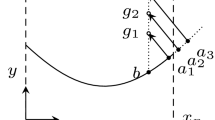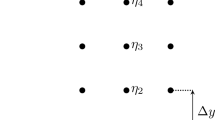Abstract
The elliptic relaxation approach of Durbin (Durbin, P.A., J. Theor. Comput. Fluid. Dyn. 3 (1991) 1–13), which accounts for wall blocking effects on the Reynolds stresses, is analysed herein from the numerical stability point of view, in the form of the \(\bar v^2 - f\) . This model has been shown to perform very well on many challenging test cases such as separated, impinging and bluff-body flows, and including heat transfer. However, numerical convergence of the original model suggested by Durbin is quite difficult due to the boundary conditions requiring a coupling of variables at walls. A ‘code-friendly’ version of the model was suggested by Lien and Durbin (Lien, F.S. and Durbin, P.A., Non linear κ − ε − υ 2 modelling with application to high-lift. In: Proceedings of the Summer Program 1996, Stanford University (1996), pp. 5–22) which removes the need of this coupling to allow a segregated numerical procedure, but with somewhat less accurate predictions. A robust modification of the model is developed to obtain homogeneous boundary conditions at a wall for both \(\bar v^2 \) and f. The modification is based on both a change of variables and alteration of the governing equations. The new version is tested on a channel, a diffuser flow and flow over periodic hills and shown to reproduce the better results of the original model, while retaining the easier convergence properties of the ‘code-friendly’ version.
Similar content being viewed by others
References
Durbin, P.A., Near-wall turbulence closure modelling without damping functions. J. Theor. Comput. Fluid Dyn. 3 (1991) 1–13.
Kalitzin, G., Application of the υ2−f Model to Aerospace Configurations. Center for Turbulence Research. Ann. Res. Briefs (1999).
Durbin, P.A., Separated flow computations with the κ − ε − υ 2 model. AIAA J. 33 (1995) 659–664.
Parneix, S. and Durbin, P.A., Numerical simulation of 3D turbulent boundary layers using the υ 2 − f model. Annual Research Briefs. Center For Turbulence Research, NASA/Stanford University (1997) 135–148.
Lien, F.S., Durbin, P.A. and Parneix, S., Non-linear υ 2 − f modelling with application to aerodynamic flows. Proceeding of the 11th Symposium. Turbulence Shear Flows, Grenoble, France, September 8–10 (1997).
Behnia, M., Parneix, S. and Durbin, P.A., Prediction of heat transfer in a jet impinging on a flat plate. Int. J. Heat Mass Transf 41 (1998) 1845–1855.
Manceau, R., Parneix, S. and Laurence, D., Turbulent heat transfer predictions using the υ 2 − f model on unstructured meshes. Int. J. Heat Fluid Flow 21 (2000) 320–328.
Jones, W.P. and Launder, B.E., The prediction of laminarization with a two-equation model of turbulence. Int. J. Heat Mass Transf 15 (1972) 301–314.
Lien, F.S. and Durbin, P.A., Non linear κ − ε − υ 2 modelling with application to high-lift. In: Proceedings of the Summer Program 1996, Stanford University (1996), pp. 5–22.
Manceau, R., Wang, M. and Laurence, D., Inhomogeneity and anisotropy effects on the redistribution term in Reynolds-averaged Navier-Stokes modelling. J. Fluid Mech. 438 (2001) 307–338.
Durbin P. A. and Pettersson Reif B.A. Statistical Theory and Modelling for Turbulent Flows. Wiley, Chichester, UK (2001)
Mansour, N.N., Kim, J. and Moin, P. Reynolds stress and dissipation budgets in a turbulent channel flow. J. Fluid Mech. 194 (1988) 15–44.
Lien, F. and Kalitzin, G., Computations of transonic flow with the υ 2 − f turbulence model. Int. J. Heat Fluid Flow 22(53) (2001) 53–61.
Lien, F.S. Kalitzin, G. and Durbin, P.A., RANS modeling for compressible and transitional flows. In: Proceedings of the Summer School Program, Center for Turbulence Research (1998) 267–286.
Wu, X. and Durbin, P.A. Boundary layer transition induced by periodic wakes. J. Turbomachin. (2000) 442–448.
Archambeau, F., Mechitoua, N. and Sakiz, M., Code Saturne: A Finite volume code forTurbulent flows I.J. of Finite Volumes (2004), http://averoes.math.univ-paris13.fr/IJFV/
Kim, J., Moin, P. and Moser, R. Turbulence statistics in fully developed channel flow at low Reynolds number. J. Fluid Mech. 177 (1987) 133–166.
Manceau, R., Karlson, J.R. and Gatski, T.B., A rescaled elliptic relaxation approach: Neutralizing the effect on the log layer. Phys Fluids 14(11) (2002) 3868–3879.
Obi, S., Aoki, K. and Masuda, S., Experimental and computational study of turbulent separating flow in an asymmetric plane diffuser. In the Ninth Symposium on Turbulent Shear Flows, Kyoto, Japan, August 16–19 (1993) 305.
Buice, C.U. and Eaton J.K., Experimental investigation of flow through an asymmetric plane diffuser. Report TSD-107, Department of mechanical engineering, Stanford University (1997).
Kaltenbach, H.-J., Fattica M., Mitta R., Lund T.S. and Moin P. Study of flow in a planar asymmetric diffuser using large-eddy simulation. J. Fluid Mech. 390 (1999) 151–185.
Apsley, D.D. and Leschziner, M.A.,Advanced turbulence modelling of separated owin a diffuser. Flow, Turbulence Combust (1999) 81–112.
Hellsten, A. and Rautaheimo, P. (ed.), 8th ERCOFTAC/IAHR/COST Workshop on Refined Turbulence Modelling, 1999.
Wilcox, D.C., Turbulence Modelling for CFD. DCW Industries (1993).
Jakirlic, S., Jester-Zurker, R. and C. Tropera, (ed.), 9th ERCOFTAC/IAHR/COST Workshop on Refined Turbulence Modelling, 2001.
Jang, Y.J., Temmerman, L. and Leschziner, M.A., Contribution to the 9th ERCOFTAC/IAHR Workshop on refined turbulence modelling.
Author information
Authors and Affiliations
Rights and permissions
About this article
Cite this article
Laurence, D.R., Uribe, J.C. & Utyuzhnikov, S.V. A robust formulation of the v2−f model. Flow Turbulence Combust 73, 169–185 (2005). https://doi.org/10.1007/s10494-005-1974-8
Received:
Accepted:
Issue Date:
DOI: https://doi.org/10.1007/s10494-005-1974-8




